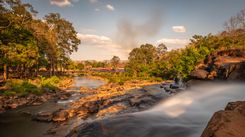You’ll need to stand at a distance to get a view of the roof, the temple’s most outstanding feature. Elegant lines curve and overlap, sweeping nearly to the ground, and evoke a bird with outstretched wings or, as the locals say, a mother hen sheltering her brood. The walls of the sim are decorated inside and out with stencilled gold motifs on a black or maroon background. As you enter the dimly lit temple and your eyes adjust to the lack of light, the gold-leaf patterns seem to float on the blackened walls.
Besides stylized floral designs, the motifs depict a variety of tales, including the Lao version of the Ramayana, scenes from the Jataka and stories about the lives of the Buddha, as well as graphic scenes of punishments doled out in the many levels of Buddhist hell. In one of these punishment scenes, on the wall to the right of the main entrance, an adulterous couple is being forced to flee a pack of rabid dogs by climbing a tree studded with wicked thorns. Other unfortunate souls are being cooked in a copper cauldron of boiling oil (for committing murder) or are suspended by a hook through their tongues (guilty of telling lies).
In the rafters above and to the right of the main entrance runs a long wooden aqueduct or trough in the shape of a mythical serpent. During Lao New Year, lustral water is poured into a receptacle in the serpent’s tail and spouts from its mouth, bathing a Buddha image housed in a wooden pagoda-like structure situated near the altar. A drain in the floor of the pagoda channels the water through pipes under the floor of the sim and the water then pours from the mouth of a mirror-spangled elephant’s head located on the exterior wall.
Covering the exterior of the back wall of the sim is a mosaic, said to depict a legendary flame tree that stood on the site when the city was founded. This particular composition is especially beautiful during the Festival of Lights, when the sim is decked out with khom fai dao, star-shaped lanterns constructed of bamboo and mulberry paper. The flickering candlelight illuminates the tree and animals in the mosaic, making them twinkle magically.
To the left of the sim, as you face it, stands a small brick-and-stucco shrine containing a standing Buddha image. The purple and gold mirrored mosaics on the pediments of the structure are especially intricate and probably the country’s finest example of this kind of ornamentation, which is thought to have originated in Thailand and spread to Burma as well. Directly behind the shrine is a larger structure known to French art historians as “La Chapelle Rouge”, the Red Chapel. The reclining Buddha image enshrined within is one of Laos’s greatest sculptures in bronze.




